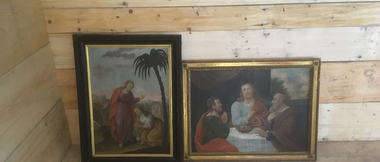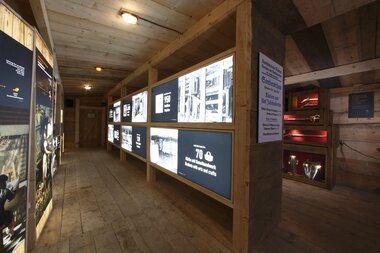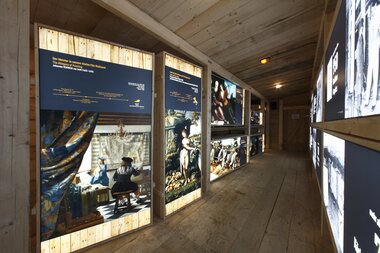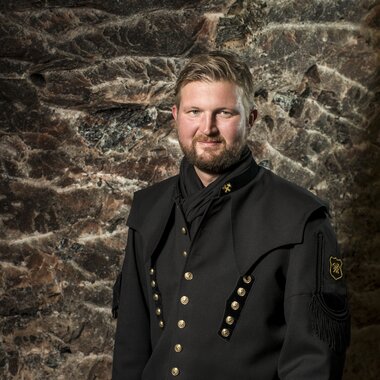"The happiness of art" Two Originals at the Springerwerk
During our research for the 2019 exhibit "The Fortune of Art", we stumbled upon two oil paintings that were salvaged amongst a trove of art treasures during the Second World War. These gems can be viewed in all their splendor during our special "Bombs on Michelangelo" tours. You can also dive deeper into the intriguing tale of how Europe's art treasures were saved on our blog.
In 2018, we hatched a plan to put together a big display at Salzwelten Altaussee, dedicated to showcasing the astonishing efforts that went into art recovery during WWII. I found myself tasked with sifting through the extensive archives of the Altaussee salt mines. The countless hours spent there gave me a sense of the sheer volume and, at times, contradicting nature of the material.
One day, a colleague drew my attention to an oil painting in her office, titled "Christ in Emmaus." It turned out that this piece was likewise one of the recovered masterpieces. Intriguingly, a note from the mine's operations manager in 1993 was attached to the back of it.

The note unfolded an intriguing story: "The two paintings had been in the 'watering room' at the Steinberghaus until October 1992. With the waterers* moving to the Erbstollen building, questions about the ownership of the paintings surfaced. The waterers claimed the paintings belonged to the staff themselves. Subsequently, management reached out to former managers and retired workers. Based on their feedback, it appears that the paintings were indeed part of the collection of hidden art treasures during WWII. After the war, no owners stepped forward to claim these paintings. As a result, the Vienna Institute for Monument Preservation gifted them to the staff as a token of appreciation for their invaluable help in recovering the artworks. Based on this, the salt mine staff are deemed to be the rightful owners. The paintings shall remain on the premises of the Altaussee salt mine, with their specific use left to the discretion of mine personnel."
*Waterers: the workers overseeing the dilution process of the salt and the precise concentration of brine produced in the mine, logging entries in the “watering book”.
A mining term specific to the salt-mining and -evaporation industry.
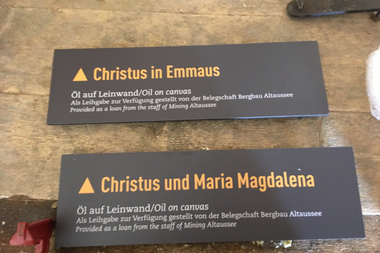
You can readily imagine the mix of surprise and awe the operations manager must have felt upon realizing the historical significance of these oil paintings from the Second World War!
The remaining task was to locate the second painting, "Christ and Mary Magdalene". The place was turned upside down as they hunted from the basement to the attic. Just when hope was fading, a painting in the break room caught an employee's eye during lunch. Lo and behold, it was "Christ and Mary Magdalene"! After a moment of stunned silence, he turned the painting around, and that very same note attesting to its provenance was stuck to its back!
Our friends at the Altaussee salt mine have generously provided these paintings to us on indefinite loan. Today, they occupy a place of honor in the Springerwerk exhibit, where they can be admired by visitors to Salzwelten. They might not be long-lost Rembrandts or Vermeers, but given their backstory, they are priceless to us.
Who knows, maybe you, too, will drop by one day and pay them a visit of your own? The best opportunity to do so is during our special "Bombs on Michelangelo" guided tours.
The art catalog of Salinen Austria includes the following description of these paintings:
- "Christ and Mary Magdalene," late 18th/early 19th century, oil on canvas. It depicts the "Noli-me-tangere" scene against a cityscape backdrop, with Mary Magdalene kneeling before the resurrected Christ, an anointing vessel by her side. Encased in a simple gold-black frame.
- "Christ in Emmaus," also late 18th/early 19th century, oil on canvas. The painting shows Christ seated with two disciples, a loaf of bread laid out on the table. A column in the background and a glimpse of the landscape beyond. Enclosed in a gilded profile frame, based upon a 17th century motif.
